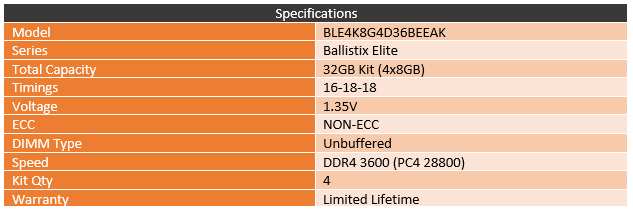Earlier this year Crucial I covered two sets of Ballistix Sport DDR4 and while I liked where they were going with the performance of the new kits I did feel the aesthetics were starting to look a little dated. Well, Crucial makes a lot of different styles of memory, especially in the Ballistix lineup and they sent over a new set which happens to be from their Elite lineup. I’m hoping their more premium kit is upgraded in looks (spoiler they are) and I’m curious how this 3600MHz kit performs as well. So let's take a look at them then run them through our testing.
Product Name: Ballistix Elite 3600MHz 32GB 4X8GB
Review Sample Provided by: Crucial/Ballistix
Written by: Wes Compton
Pictures by: Wes Compton
Amazon Affiliate Link: HERE
Packaging
So the packaging of the Ballistix Elite kit is noticeably better than the Ballistix Sport kits where they just pack all of the sticks in a plastic clamshell packaging. The Elite kit comes in a proper box that has a diamond plate design printed all over it. Then on the front, they have a silver strip across the front with the Ballistix Elite branding. The normal Ballistix logo is there as well down in the bottom left corner then in the top right corner is a sticker with the model configuration including capacity, speed, DDR version, and the stick configuration. In our case, this is a quad channel 4x8GB kit for a total of 32GB running at 3600MHz and it is DDR4 which is the standard with all Intel and AMD configurations using it for a while now.

Around on the back, they don’t have too much information. There is a sticker with the bar code in the bottom that also has the official model number. The middle has the same three boxes that our Sport kit had that shows the Ballistix hierarchy. This puts the Elite kit at the top. Below that they explain what sets the Elite kits apart from the other kits. This mentions that these are for pros and overclockers, have the fastest speeds, and the MOD software can monitor temperatures on the memory as well.

The box flips out and inside they have a “Game.Destroy.Win” quote and then below that the social media info for Ballistix. With it flipped out you can see the fill window that lets you see the memory as well.

Inside they then have two plastic trays with two memory modules each. This is no different than normal, just that they come in that fancy box where the Sport kit, for example, comes in a plastic clamshell.

Aesthetics
So with my last Ballistix memory kits, my only real complaint was that their aesthetics were starting to feel a little outdated. That isn’t to say that they looked bad, but not having heatspreaders that at least wrap around the top feels very out of date. With this Elite kit though that wasn’t a concern at all. In addition to the faster speeds and improved packaging, they come with a much nicer heat spreader. They have a weight to them from the machined aluminum portion on top. That top is also the best part about the look of the Ballistix Elite. They have a simple design with eight groves cut into each side with the Ballistix logo in the middle. This is very similar to the Tactical Tracer RGB kit that I took a look at a while back but that kit had a plastic top bar for the lighting. This kit uses the top bar to add additional surface area to pull the heat away from the memory and cool things down.

The sides of the Ballistix Elite kit have two parts in an interesting design. The heatspreader that touches the memory itself has three holes cut out on each side which if you look closely in the pictures below it means there isn’t contact on some of the memory chips. But for styling, it is cool looking. Then over those is a strip that runs the length of the memory which has the Elite branding as well as the Ballistix logo on one side. The other side has two stickers with the model name and kit information as well as the normal certification logos. The PCBs are blacked out and then the heatspreaders are mostly black to match. The secondary strip is in a dark grey that is nearly black. Overall all of the heatspreader has a textured finish which just adds to the rugged look that the kit has.

Especially with this being a quad channel kit it is going to be the top edge that you see the most when installed and because of the side at the top of this kit it really fills out the slots. They are just about as far as you can get away from the RGB memory options that have been taking over the market and I love them because of that. They are simple, heavy duty, and the black finish is going to look good in most builds. The Ballistix logos on top aren’t too in your face but they do add a little something to break things up.


Performance and Thermals
For performance testing, I put the Ballistix Elite 3600MHz kit through our normal benchmark suite. This includes a few tests using AIDA64, Cinebench, Passmark Performance Test 9, and MaxxMEM. All to get a look at overall performance at the stock speeds. Then after that, I also take a look at the thermals.
So AIDA64 is a very useful tool that allows us to get a look at a few different performance aspects including read, write, and copy speeds as well as memory latency. Testing this kit specifically stands out compared to the past kits tested because all of the other kits have been dual channel kits and this is a quad channel kit and I am testing on X299 which supports quad channel memory. You can see that difference in the read, write, and copy results from ADIA64 below where the Elite kit really pulls ahead of the other kits. The Elite kit stands out in the latency testing as well, with just the Sport LT kit running at 3600 MHz being slightly faster.




I personally prefer tests that show real-world improvements, not just memory specific tests and Cinebench R15 does show how the quad channel bandwidth and low latency can help in CPU performance.

Passmark Performance Test 9 is another synthetic benchmark but this time rather than focusing on each specific result Passmark has aggregated them all together into their Memory Mark score. In this test, the quad channel bandwidth doesn’t make as much of a difference with one of the overclocked Sport LT kits at 3800 MHz being slightly faster.

While testing in AIDA64 I did run their stress test on the memory for a half hour to heat things up and see how the larger heatspreader for the Elite kit would handle things. Below is a thermal image from during that testing. The top of the kit isn’t the hottest spot, there is a little more heat on the sides of the heatspreader around the RAM chips, but you can clearly see where the ram is on the side thermally and it is pulling the heat away from them.

Overclocking
For overclock testing I set out to overclock the Elite kit within our normal parameters. That is with the voltage locked at 1.45 volts and the timings set to the XMP setting which in this case is 16-18-18-38 and without any cooling changes. This keeps things consistent from kit to kit, this isn’t setting out to see what the max possible overclock this kit is capable. In fact just a few weeks ago this kit reached 5726 MT’s using LN2 and I know I won’t be anywhere near that. The timings for this kit are the most limiting factor, loosening them up a little would make a big difference in what we can get out of the kit. But I was curious how much room over the 3600MHz stock speed there was left. So after locking in the timings and voltage I started by booting the kit up at 3800MH, a small overclock and this went smoothly. I then rebooted and went for 4000MHz which wouldn’t boot so I had to go back to 3800 Mhz for our overclock testing.
With the moderate overclock in place I did go ahead and run through all of the same testing as before. I’m not going to go into detail on each result but it is interesting to see where the small overclock helped and where it didn’t. For example, write speeds went up but read speeds didn’t and latency actually got worse. Cinebench improved in the multi-core test but didn’t on single core and Passmark actually dropped in performance. Again our specific test parameters which limit the voltage and use the XMP timings really hurt the Ballistix Elite kit when overclocking. That said using the same requirements this kit did outperform the Ballistix Sport kit I reviewed last but that kit did offer more headroom from the stock clock. Considering they are using Micron E-die memory ICs you aren’t going to find a better kit for overclocking once you loosen up the timings a little bit, E-dies have been dominating the overclocking records left and right.
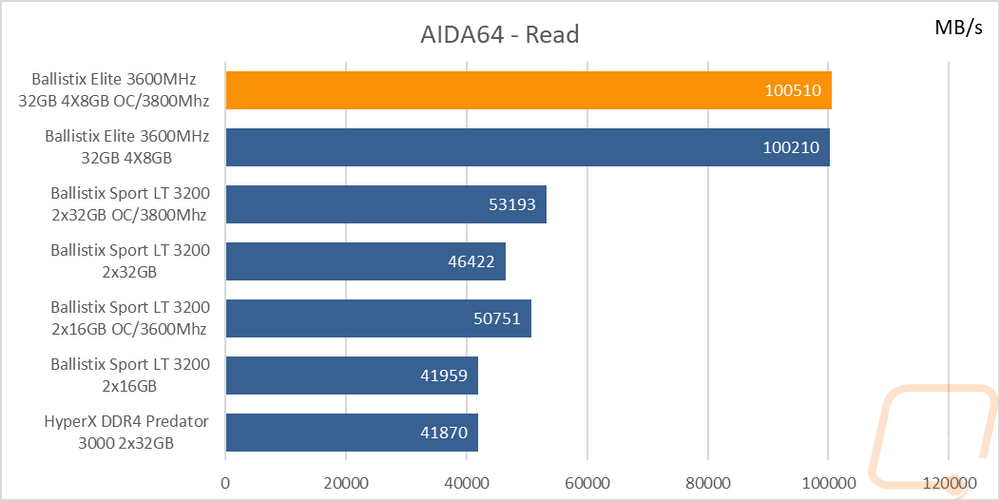
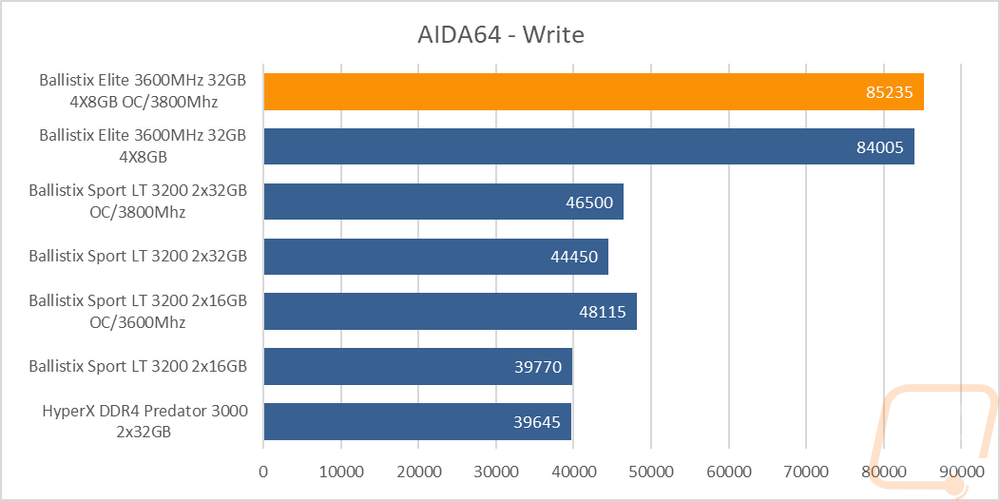
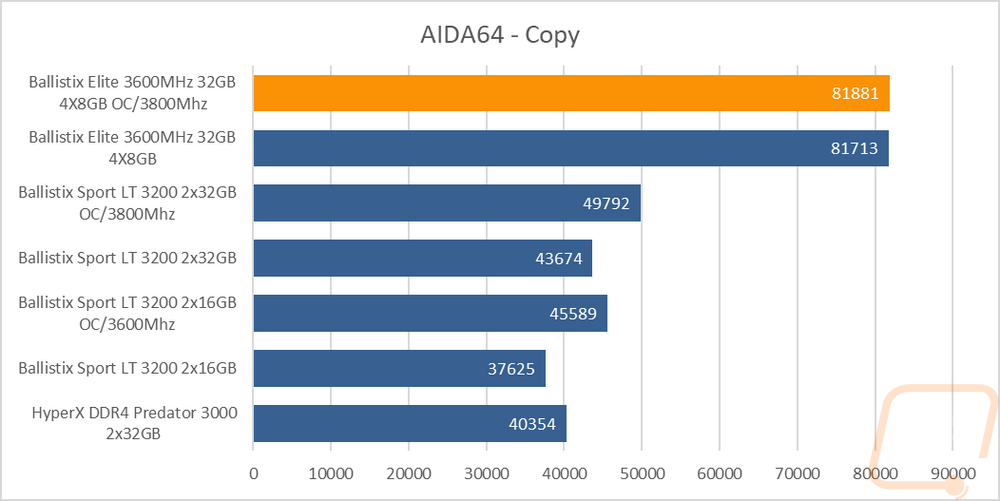
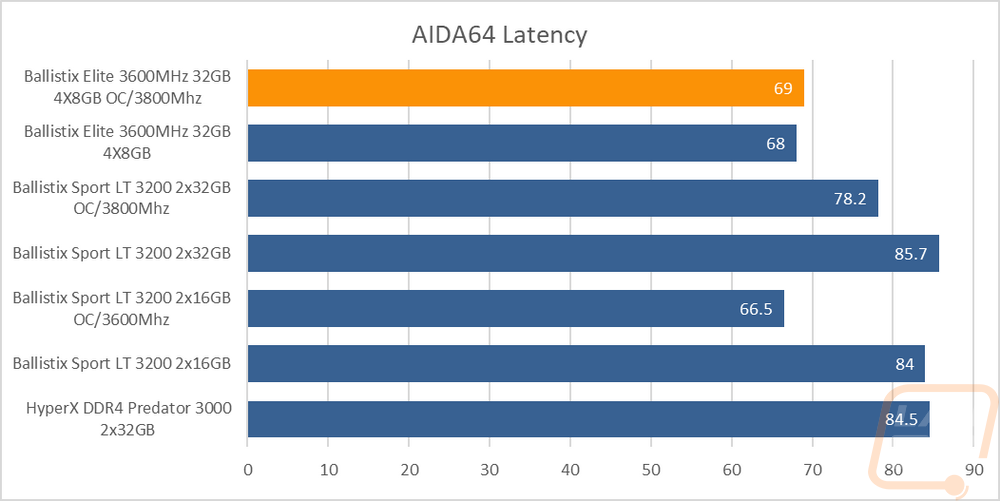
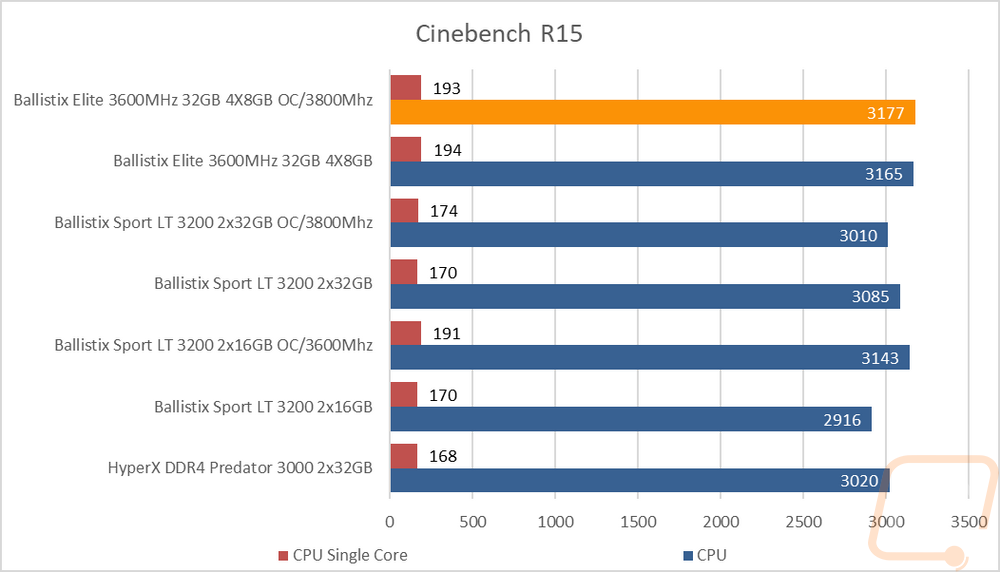
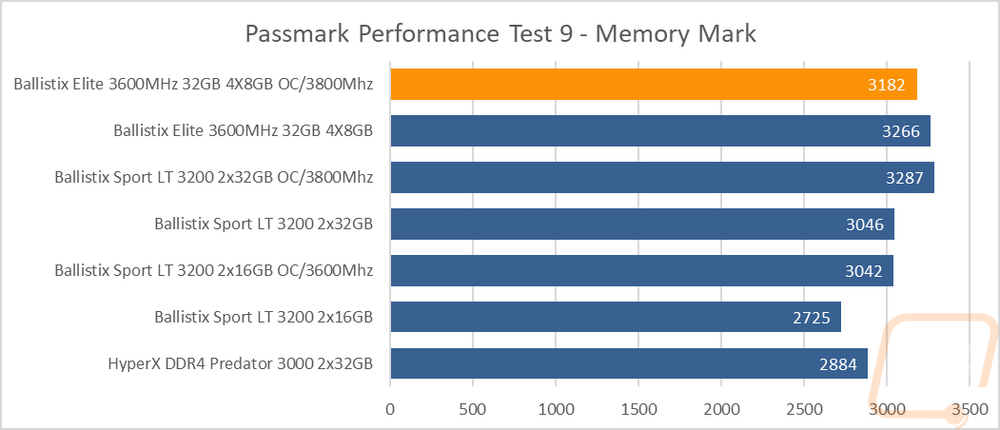
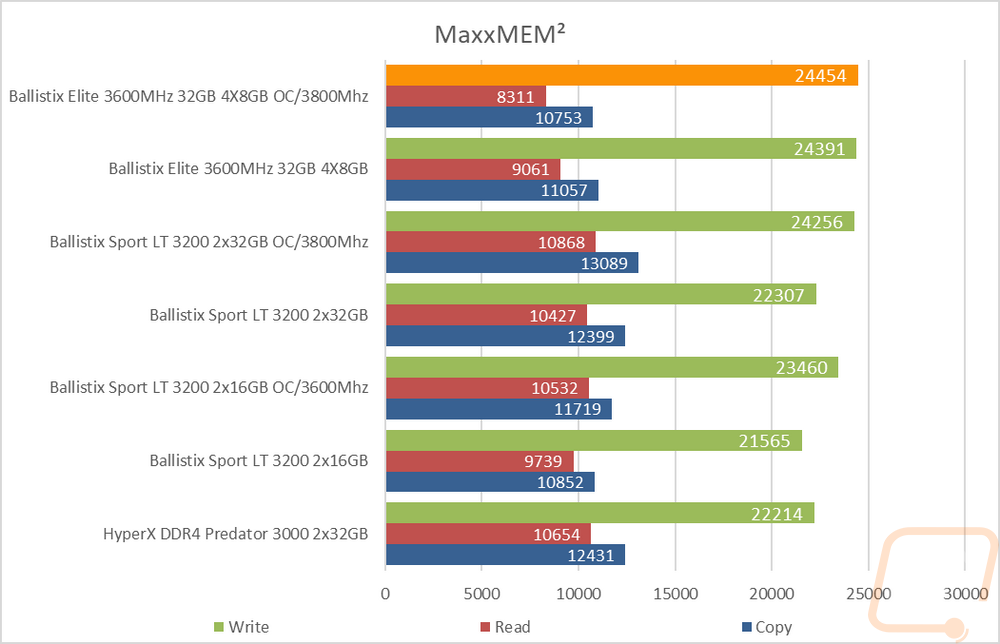
Overall and Final Verdict
Having spent time with the Ballistix Sport kits a while back it was a nice change to check out the Ballistix Elite 3600 MHz kit. The Sport kit looked good but was a little dated looking with its heatspreader design where the Ballistix Elite kit doesn’t hold back on its heatspreader design. In fact, just holding the kit in hand and feeling the overall weight makes the difference clear and that is before you even look at the kit. The Ballistix Elite kit is a big step up in aesthetics, I love their all blacked out design that isn’t in your face or flashy. Being black also means they will match nearly any build, especially with most motherboards being black or dark grey. Of course, the heatspreader design doesn’t have much to do with performance other than cooling to a small extent but the Ballistix Elite 3600 MHz kit ended up performing extremely well. The 3600 Mhz clock speed helps a little with that but you can still get 4x8GB kits at that clock speed, it’s the timings though that stand out. Just about everything else on the market (in comparable capacity/density) is running a CAS latency of 18 where this kit is running at a CL of 16 and that is where this kit stood out. This showed in the performance testing though it did hurt the kit in our overclocking testing. The Ballistix Elite kit is very capable of overclocking though once the timings are loosened up but even at these the kit did still have a little room left.
My only complaint about the kit overall was with its pricing and even that comes with some caveats. The kit tested running at 3600 MHz with a 4x8GB configuration for 32GBs is selling for $385.99 on Newegg and Amazon. When sorting out competing kits at the same clock speed, capacity, and density the Ballistix Elite kit looks a little expensive. You can even find a kit at about half the price. When looking closer though you will notice all of those have significantly worse timings. That $192 kit is running a nasty 18-22-22-42 vs the 16-18-18-38 of the Elite kit. So the timings push this up in with the expensive RGB and gold plated 3600MHz kits but it trades all of that bling for better performance. So it's an expensive kit, but the price is at least partially justifiable.


Live Pricing: HERE


